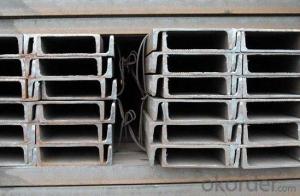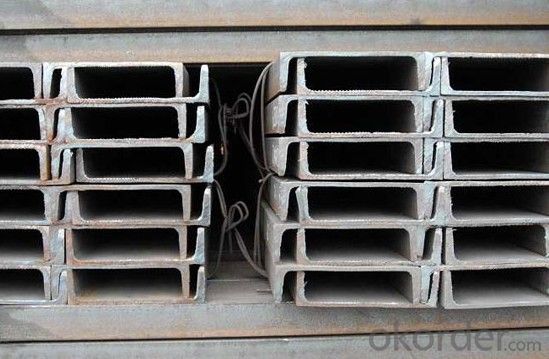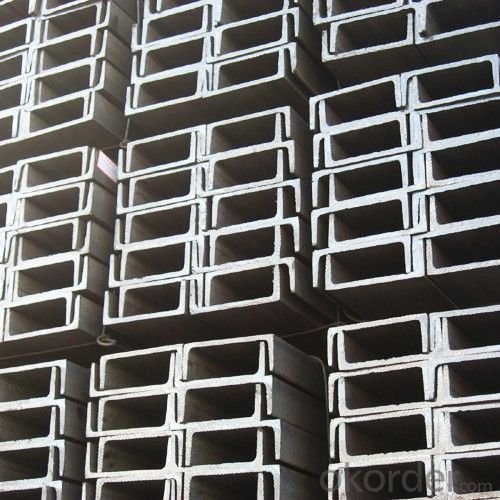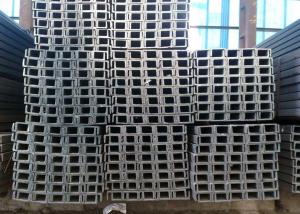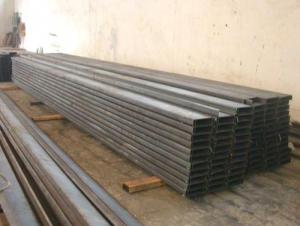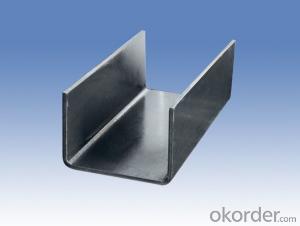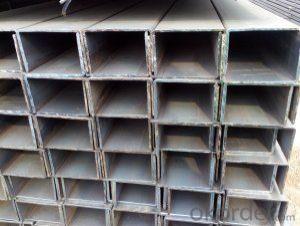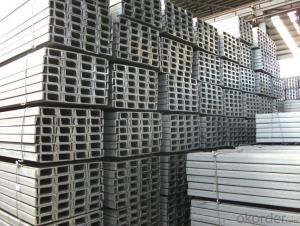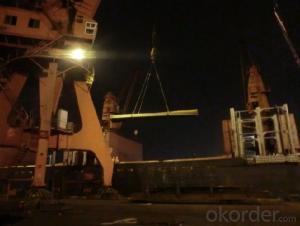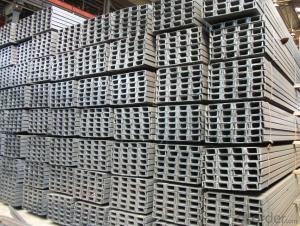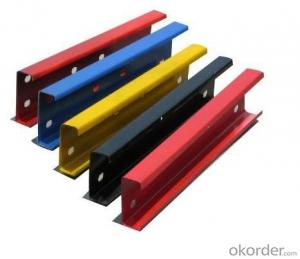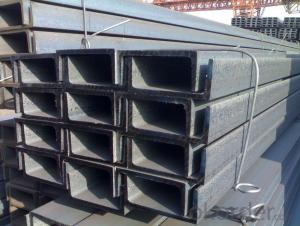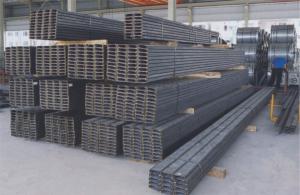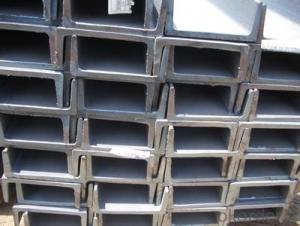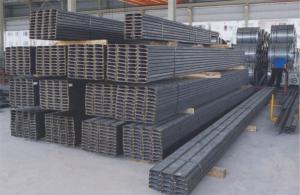Good Quality U-STEEL
- Loading Port:
- China Main Port
- Payment Terms:
- TT OR LC
- Min Order Qty:
- -
- Supply Capability:
- -
OKorder Service Pledge
OKorder Financial Service
You Might Also Like
Specifications
1, U Channel steel
2.Size:25*25*3mm-250*250*35mm
3.Standard: AISI, ASTM, BS, DIN, GB, JIS
4.Grade: Q235.SS400.Q345 etc.
Dimension (mm) | Web thickness (mm) | Flange thickness(mm) | Weight (kg/m) |
75*40 | 3.80 | 7.00 | 5.30 |
75*40 | 4.00 | 7.00 | 5.60 |
75*40 | 4.50 | 7.00 | 5.85 |
75*40 | 5.00 | 7.00 | 6.92 |
100*50 | 3.80 | 6.00 | 7.30 |
100*50 | 4.20 | 6.00 | 8.03 |
100*50 | 4.50 | 7.50 | 8.97 |
100*50 | 5.00 | 7.50 | 9.36 |
125*65 | 5.20 | 6.80 | 11.66 |
125*65 | 5.30 | 6.80 | 12.17 |
125*65 | 5.50 | 8.00 | 12.91 |
125*65 | 6.00 | 8.00 | 13.40 |
150*75 | 5.50 | 7.30 | 14.66 |
150*75 | 5.70 | 10.00 | 16.71 |
150*75 | 6.00 | 10.00 | 17.90 |
150*75 | 6.50 | 10.00 | 18.60 |
150*75 | 9.00 | 12.50 | 24.00 |
- Q: The types of channel steels are 6, 8, 10, 12, 16, 20, 25, 32 and 14. What are their tensile strength of these types of channel steel?
- Tensile strength and yield strength are independent of size and size, but only material.
- Q: Are steel channels prone to rusting?
- Yes, steel channels are prone to rusting if they are not properly protected or coated.
- Q: What are the considerations for steel channel connections to timber structures?
- When considering steel channel connections to timber structures, there are several important factors to keep in mind. Firstly, it is crucial to ensure that the connection is structurally sound and able to withstand the required loads and forces. This involves carefully calculating and designing the connection to ensure that it can bear the expected load without failure. Secondly, compatibility between steel and timber should be considered. Different materials have different expansion and contraction rates, so provisions must be made to accommodate these movements and prevent any potential issues, such as splitting or excessive stress on the connection. Additionally, the connection should be designed to prevent corrosion, as steel is susceptible to rusting. Proper measures, such as using protective coatings, galvanizing, or isolating materials, should be implemented to minimize the risk of corrosion and ensure the long-term durability of the connection. Lastly, it is important to follow applicable building codes and regulations when designing and constructing steel channel connections to timber structures. These codes provide guidelines and standards that must be adhered to in order to ensure the safety and structural integrity of the connection.
- Q: Can steel channels be used for framing door and window openings?
- Yes, steel channels can be used for framing door and window openings. Steel channels are commonly used in construction for structural support and framing purposes. They are known for their strength and durability, making them suitable for framing openings. Steel channels provide a sturdy framework that can support the weight of the doors and windows without flexing or warping. Additionally, steel channels offer excellent resistance to corrosion and can withstand extreme weather conditions, making them a reliable choice for framing door and window openings in both residential and commercial buildings.
- Q: What are the limitations of using steel channels?
- One limitation of using steel channels is their weight, which can make them difficult to handle and install. Additionally, steel channels may be prone to corrosion, especially in environments with high humidity or exposure to chemicals. Another limitation is their cost, as steel channels can be more expensive compared to other building materials. Lastly, steel channels may have limited design flexibility, as they are typically available in standard shapes and sizes.
- Q: What are the different methods of protecting steel channels from fire?
- There are several methods available to protect steel channels from fire. One common method is to apply a fire-resistant coating or paint to the surface of the steel channels. These coatings are designed to provide a protective barrier that can withstand high temperatures and prevent the steel from reaching its critical temperature, which is when it begins to lose its structural integrity. These coatings can be applied through various techniques such as spraying, brushing, or rolling. Another method is to encase the steel channels in fire-resistant materials such as concrete or gypsum board. This creates a physical barrier that insulates the steel from the heat of the fire, preventing it from reaching its critical temperature. This method is commonly used in construction projects where fire resistance is a critical requirement. Intumescent coatings are another effective method of protecting steel channels from fire. These coatings are specially designed to expand when exposed to high temperatures, forming an insulating char layer that protects the steel from the fire. Intumescent coatings can be applied as paints or sprays and are commonly used in buildings, particularly in areas where steel channels are exposed to fire risks. In addition to these methods, fireproofing materials such as fireproof wraps or blankets can be used to protect steel channels. These materials are typically made from fire-resistant fibers or fabrics and are wrapped around the steel channels to provide insulation and prevent the transfer of heat. Finally, proper fire safety measures such as installing fire suppression systems, smoke detectors, and fire alarms in the vicinity of steel channels can also help protect them from fire. These measures can help detect and control fires at their early stages, minimizing the risk of damage to the steel channels. Overall, there are various methods available to protect steel channels from fire, ranging from coatings and encasements to fireproofing materials and fire safety systems. The choice of method depends on factors such as the specific requirements of the project, the level of fire protection needed, and the budget constraints.
- Q: Specification for channel steels used in fork trucks
- Specifications are as follows:25a:250x78x7x1228a:280x82x7.5x12.530a:300x85x7.5x13.5
- Q: 14# dimension of channel steel and weight per metre?
- Dimensions and weight of light rolled channel steel14#a height (H) 140, leg width (b) 62, waist thickness (d) 4.9, theoretical weight 13.3 kg14# height (H) 140, leg width (b) 58, waist thickness (d) 4.9, theoretical weight 12.3 kg
- Q: Installation of floor type distribution box, foundation channel production and installation, the quota should choose which two?
- Floor type distribution box installation cannot apply the distribution cabinet installation, and should set floor type of distribution box installation quota; installation set foundation channel steel foundation channel steel installation item.
- Q: What are the different finishing techniques for steel channels?
- There are several different finishing techniques that can be used on steel channels to enhance their appearance and protect them from corrosion. One common finishing technique is galvanizing. This involves coating the steel channels with a thin layer of zinc, which provides excellent corrosion resistance. The zinc coating can be applied through either hot-dip galvanizing, where the channels are immersed in a bath of molten zinc, or through electroplating, where an electric current is used to deposit the zinc onto the surface of the channels. Galvanized steel channels have a distinctive silver-gray appearance. Another finishing technique is powder coating. This involves applying a dry powder to the steel channels and then baking it in an oven to create a durable and decorative finish. Powder coating is available in a wide range of colors and can provide a smooth and even coating on the channels. Painting is another common finishing technique for steel channels. This involves applying a liquid paint to the surface of the channels. The paint can be applied through various methods such as brushing, spraying, or dipping. Painting not only enhances the appearance of the channels but also provides a protective barrier against corrosion. In addition to these techniques, steel channels can also be polished or brushed to create a smooth and shiny surface. Polishing involves using abrasive materials to remove any imperfections and create a reflective surface. Brushing, on the other hand, involves using a wire brush or abrasive pad to create a textured finish on the surface of the channels. Overall, there are several different finishing techniques available for steel channels, each with its own advantages and aesthetic appeal. The choice of finishing technique will depend on factors such as the desired appearance, corrosion resistance requirements, and cost considerations.
Send your message to us
Good Quality U-STEEL
- Loading Port:
- China Main Port
- Payment Terms:
- TT OR LC
- Min Order Qty:
- -
- Supply Capability:
- -
OKorder Service Pledge
OKorder Financial Service
Similar products
Hot products
Hot Searches
Related keywords
